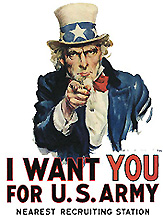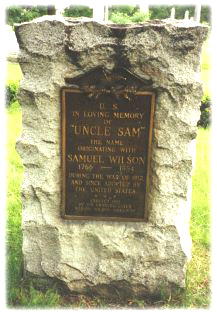|

Who Is Uncle Sam?
Historians aren't completely certain how the character "Uncle Sam" was created, or who (if anyone) he was named
after. The prevailing theory is that Uncle Sam was named after Samuel Wilson.
Wilson was born in Arlington, Mass., on September 13, 1766. His childhood home was in Mason, New Hampshire. In
1789, he and his brother Ebenezer walked to Troy, New York.
During the War of 1812, Wilson was in the business of slaughtering and packing meat. He provided large shipments
of meat to the US Army, in barrels that were stamped with the initials "U.S." Supposedly, someone who saw the "U.S." stamp
suggested -- perhaps as a joke -- that the initials stood for "Uncle Sam" Wilson. The suggestion that the meat shipments came
from "Uncle Sam" led to the idea that Uncle Sam symbolized the federal government.
Samuel Wilson died in 1854. His grave is in the Oakwood Cemetery in Troy.
Uncle Sam's traditional appearance, with a white goatee and star-spangled suit, is an invention of artists and
political cartoonists; Samuel Wilson did not look like the modern image of Uncle Sam. For example, Wilson was clean-shaven,
while Uncle Sam is usually portrayed with a goatee.
Thomas Nast, a prominent 19th-century political cartoonist, produced many of the earliest cartoons of Uncle Sam.
However, historians and collectors take note: Many of Nast's cartoons may appear to depict Uncle Sam, while in fact they depict
Yankee Doodle or "Brother Jonathan." It is easy to mistake a Brother Jonathan cartoon for one of Uncle Sam, since both figures
wear star-spangled suits of red, white and blue. As a rule, Brother Jonathan was drawn with a feather in his cap, while Uncle
Sam was not; and Uncle Sam is nearly always drawn with a beard, while Brother Jonathan was clean-shaven.
Some have suggested that Dan Rice, a 19th-century clown, inspired Thomas Nast's Uncle Sam cartoons. Rice's clown
costume consisted of a hat and star-spangled suit, much like the costome worn by Uncle Sam. However, Rice was born in 1823,
and did not begin clowning until 1844; and Uncle Sam cartoons appeared as early as 1838. Therefore, it seems unlikely that
Rice was, in fact, the inspiration for Nast's cartoons.

The single most famous portrait of Uncle Sam is the "I WANT YOU" Army recruiting poster from World War I. The poster was
painted by James Montgomery Flagg in 1916-1917.

Samuel Wilson is buried in the Oakwood Cemetery, in the Northern part of Troy, New York.
Uncle Sam...The National Icon
From his original inception as merely a phrase used amongst the troops of 1812, to a character with actions and
personality, and then to an icon recognizable around the world, Uncle Sam has fulfilled many roles in the construction of
American symbology. He has been an icon with which Americans could identify, and by which others identified us. On another
level, Uncle Sam has helped to define the relationship between the American people and their government.
While Uncle Sam is globally associated with the nation as a whole, for many Americans Sam is a symbol specifically
of the federal government. He is comparable to a kinder, gentler, Big Brother. Yet despite this strong relationship in popular
culture between Uncle Sam and the government, he was not officially adopted until 1950. It was then that the State Department
finally recognized the need for a standardized image of Uncle Sam, not only for Americans -- who had a pretty good idea what
he looked like and stood for already -- but especially for the rest of the world, which had been producing its own, often
uncomplimentary, versions.
Like many other American symbols, Uncle Sam was not produced by the government, or some propaganda office,
and then filtered down to the masses. Rather Sam, like Yankee Doodle and Brother Jonathan, originated in popular culture and,
after a hundred and thirty-seven years of almost Darwinian evolution amongst the masses, was only officially adopted when
it had already become a national image.
The creation of symbols such as the Seal of the United States, while produced officially, also reflect the same
kind of evolution. The final version of the seal was not adopted until 1884, one hundred and ten years after Jefferson first
began to consider its design. The eagle, one of the symbols which make up the seal, was one of the many compromises that went
into the final version. The same can be said of the starred helmet of Lady Freedom, who was placed atop the Capitol Building
in 1863. Her original headgear had been a liberty cap which was discarded due to its association with antislavery sentiments.
The popularity of Uncle Sam as a national symbol after 1812 can be seen as America's first step toward a sense
of identity other than regional. Previous symbols, such as Yankee Doodle and Brother Jonathan originated and referred specifically
to New Englanders. While foreigners associated these figures with the nation as a whole, internally they were linked to the
North and represented that region alone. To many residents of the South, Yankee Doodle and Brother Jonathan were completely
alien images.
Uncle Sam, although closely related to both figures in appearance -- especially Brother Jonathan -- did not become
specifically allied to the North until the Civil War. Sam's increasing resemblance to Abraham Lincoln and Northern values
made him an outcast in the South. After the war, however, Sam began to regain his popularity across the nation. By 1917 Uncle
Sam was a national icon -- immediately recognizable across the globe.
While a large part of Uncle Sam's popularity lies with his lack of definitive link to a specific region, there
were two other main factors. The first of these was Sam's role as an unofficial uncle. Unlike many figures representing national
governments, Sam was not a monarch or any other kind of ruler. He protected and maintained, but he did not rule or punish.
Uncle Sam was not a father or authority figure.
This was a very important distinction to the American populous. While the figures of Yankee Doodle and Brother
Jonathan were also non-authoritative, they had also cast and bestowed by outsiders -- specifically Native Americans and Europeans.
These symbols did not carry the weight necessary for a young nation trying to make its way in the global community. Uncle
Sam was the first national symbol which originated from within and, while European influences such as the British Punch did
attempt their own portrayals of his figure, Uncle Sam remained an American product.
Today Uncle Sam has entrenched himself in American symbology. His image is permanently intertwined with the concept
of the nation that the American public holds in its mass consciousness -- an image which also rests in the minds of every
want-to-be citizen not yet or just recently arrived. Perhaps even more important than the part Sam plays in our own self-identification,
is his crucial role in the way the rest of the world relates to us. For all intents and purposes, Uncle Sam is here to stay.
|

